The 2023 National Digital Forum (NDF) conference was held on November 20-21, 2023 at the Museum of New Zealand Te Papa Tongarewa. Sessions were recorded and will be made available on the NDF YouTube channel. I was pleased to have the opportunity to give a presentation on AI Literacy and received some good feedback from audience members. One change I noticed from pre-pandemic NDF conferences was not having a live Twitter conference feed at this conference, especially since NDF previously had a very robust and lively presence there thanks to numerous attendees posting frequently about the sessions. Some recurring themes included the handling of indigenous data and art, needing to subtract not just add programs and projects, reaching underserved audiences, and using museums to tackle contemporary issues and topics since they are a trusted source of information. The following are my notes from sessions I attended and links to some of the resources mentioned.
Upcoming related conferences noted by presenters:
- Fantastic Futures Canberra 2024 – International Conference on AI for Libraries, Archives, and Museums (AI4LAM) on October 16-18, 2024
- Future of Arts, Culture and Technology Symposium 2024 –at ACMI February 14-15, 2024
Day 1
Hon. Simon Kofe
Kofe discussed the challenges of his island nation of Tuvalu in facing submersion in 50 to 200 years. He said they wondered what they can offer on the international stage and found that they had ethics and values about communal living and being a good neighbor that other nations could learn from. Their recently updated constitution specifies that Tuvalu shall retain statehood regardless of physical territory or not. These initiatives would make it the first digital nation and one that could have online jurisdiction. For the digital twin of the island, he acts as an avatar giving a tour of island. Kofe sees the overriding question being: How can we use tech to improve lives of people and preserve our culture? He creatively called it the Digital Arkive, preparing for worst-case scenario of flooding of the island.
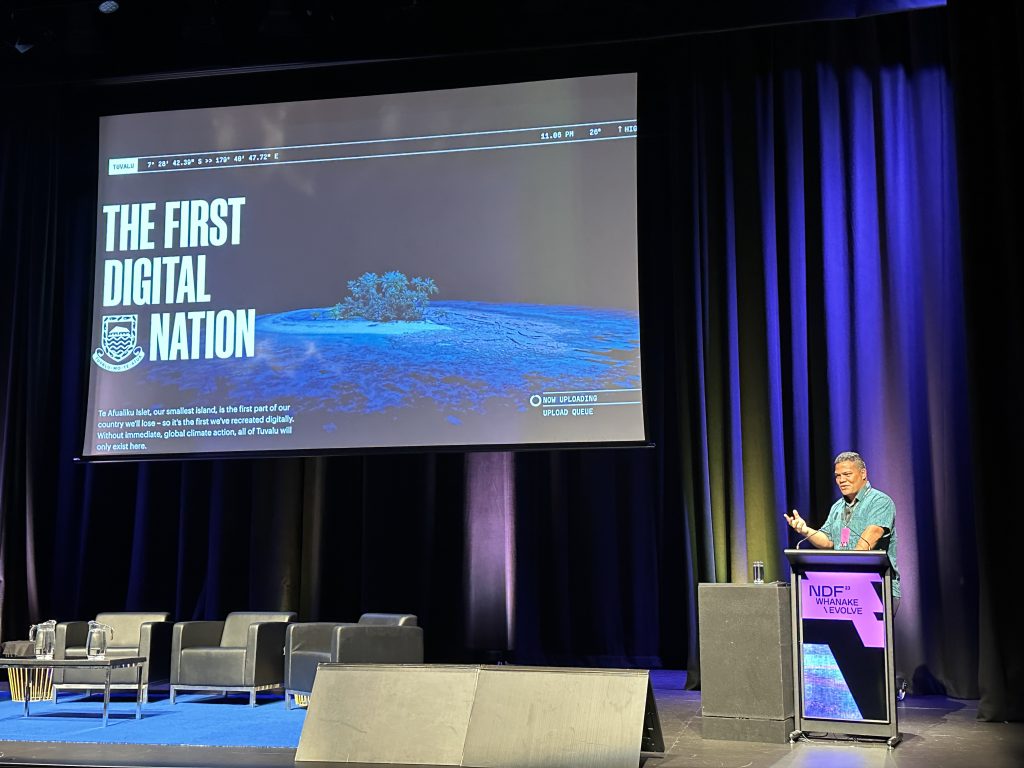
Jane Alexander (The Cleveland Museum of Art) – Breaking New Ground in Mixed Reality
Alexander discussed a recent exhibition called Revealing Krishna: Journey to Cambodia’s Sacred Mountain that used 84 HoloLens mixed reality headsets (donated by Microsoft) to enhance the museum’s storytelling around Cambodian stone sculptures. She said the user experience (UX) design meant considering how to guide 6 people per group who’d never used HoloLens before without making it overwhelming or confusing. They ended up being successful using footprints marked on the ground and closed captions. She said 97% of people going through the exhibit opted for the HoloLens tour and had high satisfaction with it. The use of this technology meant that they were able to get all 8 gods together for the first time in 1500 years.
Puawai Cairns (Te Papa) – Planting Seeds of Change
Cairns focused on some of the challenges in making change in the GLAM sector. She asked, What are you prepared to leave behind, to make change? And noted that she likes to think of herself as a critical friend, rather than a nag, when it comes to these issues. She said to remember to think beyond buildings and exhibits, which are expensive to maintain and have limited reach and impact.
Dr. Sereana Naepi (Matada Research) – Facilitating a connection between Museums and Pacific Peoples
Naepi started right away by saying don’t believe the rumors, Pacific People are really interested in museums and not just their own collections. According to her research of Pacific audiences (see report Pride, belonging & identity: Exploring access to and consumption of museum content by Pacific Peoples), all users (low, med, high users) of the museum had interest in the Pacific collection but also science, dinosaurs, etc. She said they loved being able to talk to people if there were staff available in the exhibit areas. They did notice that they never see an ad for museums in South Auckland and wanted to know why ads aren’t in their communities. E.g. Ads are in Britomart but not elsewhere. One participant mentioned that they miss how MOTAT in Auckland used to have a free day annually based on area code. There is a desire for an inclusive, community-centered approach to museums.
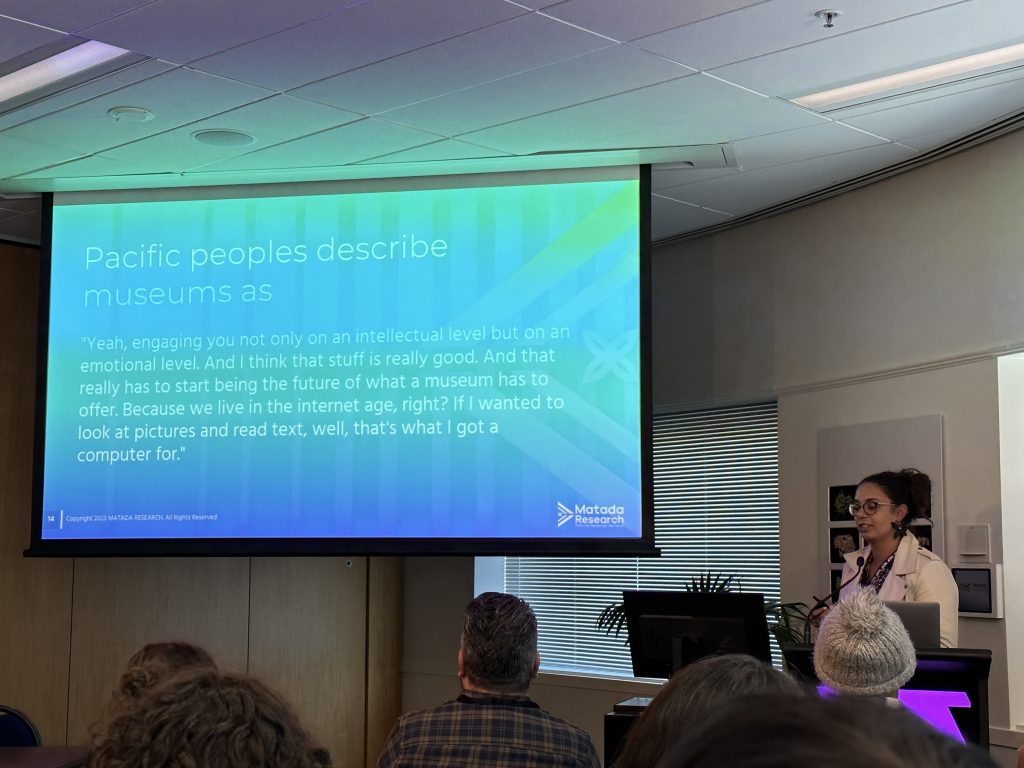
Rene Burton & Dr. Johnson Witehira (National Library of NZ & Indigenous Design and Innovation Aotearoa) – Online Presence to Support Māori Achieving Success as Māori
Burton and Witehira talked about their initiative to make a safe space online for Māori, and how it was made specifically for kura, not English-medium schools, because they tend to get less support than English schools. Their online space incorporates lots of Māori elements like mihi and going from bottom of page to top. It’s also all in Te Reo.
Rebecca Coronel & Dr. Keir Winesmith (National Film and Sound Archive of Australia) – AI, Machine Learning, and Audiovisual Collections at NFSA
Coronel and Winesmith provided an overview of their experiences using machine learning with their audiovisual collections at the NFSA in Australia, which includes Mad Max: Fury Road. They mentioned the ratio of physical to online: for every 1 person physically, there are 4000 online visitors. Also, magnetic tape media is at risk of becoming degraded, hence the Deadline 2025 program. They wanted to run an AI pilot to make the collection searchable by any term and make it easier to find content. There was value in the facial recognition feature (though still biases) and OCR and transcripts (e.g. finding a speech about Queen Elizabeth II). Some limitations were that it didn’t filter out offensive content, and the Australian accent and First Nation terms were a challenge for the system. One concept was that after the computational archive comes the conversational archive. They called their AI a “primary source model” not a large language model (LLM) and thus less likely to hallucinate or make up information. They said we trust what’s in the knowledge graph; it’s translation not replacement
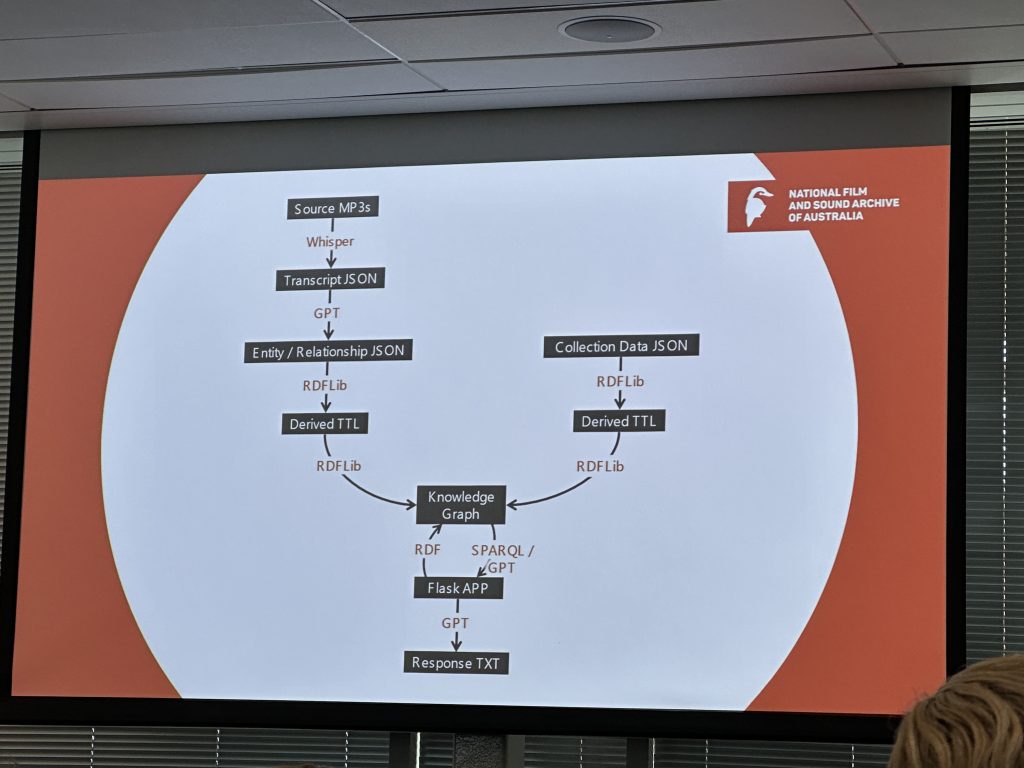
An example they gave of what might be discoverable with AI and not a traditional catalog entry is someone mentioning in an oral history that they “had dinner with Spielberg”. When looking to see when someone’s acting career took off, this would likely be more important than a piece of information that the actor “acted in [ABC movie]”. Part of the benefit of AI is then that it can surface things beyond what a staff member decided and catalogued at one point in time.
Peter-Lucas Jones – Data Sovereignty
Apps Jones mentioned:
- Whare Korero – Maori content
- Korero Maori – app to train computers in te reo Maori
- Kaituhi – automatic te reo Maori transcription
- Rongo – pronunciation app
Jones discussed the challenges and opportunities of teaching computers indigenous languages because there aren’t often enough people to do the work. They ran a competition to get data and received 316 hours of Māori language across 10 days of the competition. The Kaituhi system can do automatic bilingual transcription thanks to 8 CPUs from Nvidia to do the work in-house. You can upload a Maori language file and it will make a transcript. Jones noted that it requires cultural intelligence to tag Maori speech as part of training computer systems. The Rongo app can benchmark pronunciation against a native speaker and traditional sound, but this also raises questions about telling people they have a ‘wrong’ pronunciation.
Jones touched on some issues with the FLEURS open-source dataset for language, including a lack of proper peer review for FLEURS.
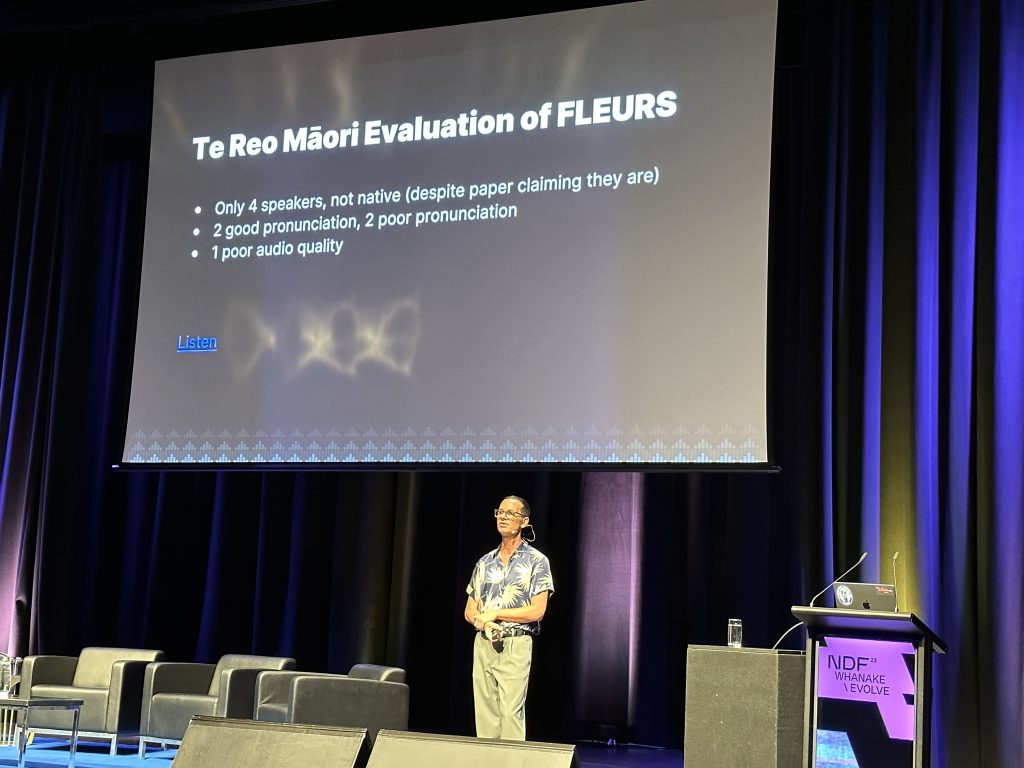
OpenAI’s Whisper also has issues, and it’s a reminder to be skeptical about the capacities and testing that goes into these language models. He referred to an MIT Tech Review article A new vision of artificial intelligence for the people about some of the projects Jones is involved in.
The changes in languages will also pose challenges. For example, usually Polynesian languages go down at the end of sentences when spoken, but in NZ the “penultimate rise” reflects a change in speaking patterns. Jones cautioned that AI is just a new way to make money especially given it’s being run by corporations.
Seb Chan and Dr. Indigo Holcombe-James (ACMI) – Digital State(s) of Play: Where are we going?
Chan and Holcombe-James covered a range of topics relating to AI, GLAM audiences and staff, and digital exclusion in Australia. They mentioned a book relating to China and blockchain chickens and a commentator calling the current age a new era of infinite media. They referenced a New Yorker article recently published about Holly Herndon and her machine-learning model called Holly+ that allows others to make artwork with her voice. According to the Australian Digital Inclusion Index, 9.4% are highly digitally excluded in Australia. They said that the claims that creativity is safe from AI—stemming from consulting companies’ reports on jobs and AI—seem underbaked. They pointed to how DALL-E et. al can do all this stuff already.
They discussed wanting to design for a high-attention media environment and how we want audiences to behave, not just design for click-bait, Tik-Tok style things. They asked, how do we slow visitors down, not just cater for their short-term needs. They emphasized that museums and libraries staff should be doing tech courses, and STEM students should be working in museums and libraries, and get ethics views—essentially more collaboration across fields. They said given the limited workforce and skills shortages in GLAM, the sector needs to share expertise better and share workers.
There were a few challenges laid out. How do we recalibrate our work in no money environment / future of climate issues? How do we get better about talking about the retirement of institutions or programs if they’re no longer serving their purpose. How do we address the low computational literacies in our communities and lack of time to consider where we want to be? The trend of trying to plan for the future in a rushed day workshop in a moment of great anxiety and fear of immediate future doesn’t offer enough time. They said we lack ways of working at planetary scale, which is what is needed, and need to find ways to use our physical spaces better and in a more focused way.
Day 2
Dr. Troy Innocent (RMIT Future Play Lab) – Play About Place
Director of the Future Play Lab at RMIT University, Innocent covered the topic of play as one method that can bring people into change; it’s immersive, with or without tech, a space of possibility, imagination, and creativity. It’s also embodied and opens up the world. He discussed how speculative design underlies urban play and design and gave some examples, including 64 Ways of Being and a Christchurch project. He also mentioned the book The Library as Playground: How Games and Play are Reshaping Public Culture by Dale Leorke and Danielle Wyatt.
Colby Raley (Microsoft) – AI for Cultural Heritage
Raley gave a brief history of where AI has come from and the introduction of the transformer in the paper: Attention is All You Need. She offered some examples of AI used in positive ways, such as the Be My AI from Be My Eyes for people who are blind/low-vision and the Revolution of Hip Hop pop-up exhibit that used AI to make hip hop history more interactive and less like a lecture. Her closing challenge to the audience was to get across this and be across risks and opportunities (not just hype like the Metaverse).
Dr. Kara Kennedy – From Artifacts to Algorithms: Fostering AI Literacy
This was my own presentation (lightning talk format) focused on AI literacy and the need to prepare for an AI-driven world, particularly since the introduction of generative AI tools like ChatGPT that are impacting education, jobs, art, and more. I introduced my AI Literacy Framework and made the case for not letting the existing digital divide become the AI divide and encouraging everyone to develop their AI literacy skills.
Dr. Johnson Witehira (Indigenous Design and Innovation Aotearoa) – Decolonising Futures
Witehira showed examples of his work on decolonizing digital spaces. He’s currently working on a typeface that integrates Māori design. Previously he developed Maoriland, an early video game, and The River Between Us at the Dowse. He said there’s not a lot of hustle in curatorial spaces or academia, so he likes to have the chance to just do stuff. An international example was when he was able to show Maori art on 36 screens in Times Square, New York, as well as bringing some of them to Toronto. He mentioned how it was important when indigenous residency programs supported families too, rather than just a lone artist. He also mentioned the stigma associated with video games as a concept, finding more luck with the term playable artwork. More information is available at The Space Between Us site.
Emily Loughnan – Curio [sponsor]
Curio was born out of Mahuki Innovation Lab and aims to be an accessible way to bring interactive displays to GLAM organizations. There’s also a free option to try it out. Examples of it in use include a bird display in Cornwall Park in Auckland and a Shakespeare First Folio display in Pennsylvania, USA.

Tara Fagan and Mel Thompson (Te Papa) – 4D. Expanding Horizons: Unleashing the Power of Online Courses
Fagan and Thompson provided an overview of a project at Te Papa in collaboration with EducationNZ to develop free courses on NZ topics in the Future Learn online course platform. They talked about how online courses such as via Coursera had a big uptake rate in the Asia region, that Massive Open Online Courses (MOOCs) have fewer obstacles (gender, geography, etc.) to some learners, and that despite the publicized low completion rate for such courses, sometimes this is just because people are dipping in and out for content they want. They discussed how museums have high trustworthiness among the public (see the Museums and Trust report 2021) and raised the question of whether this means they have an obligation to do more education.
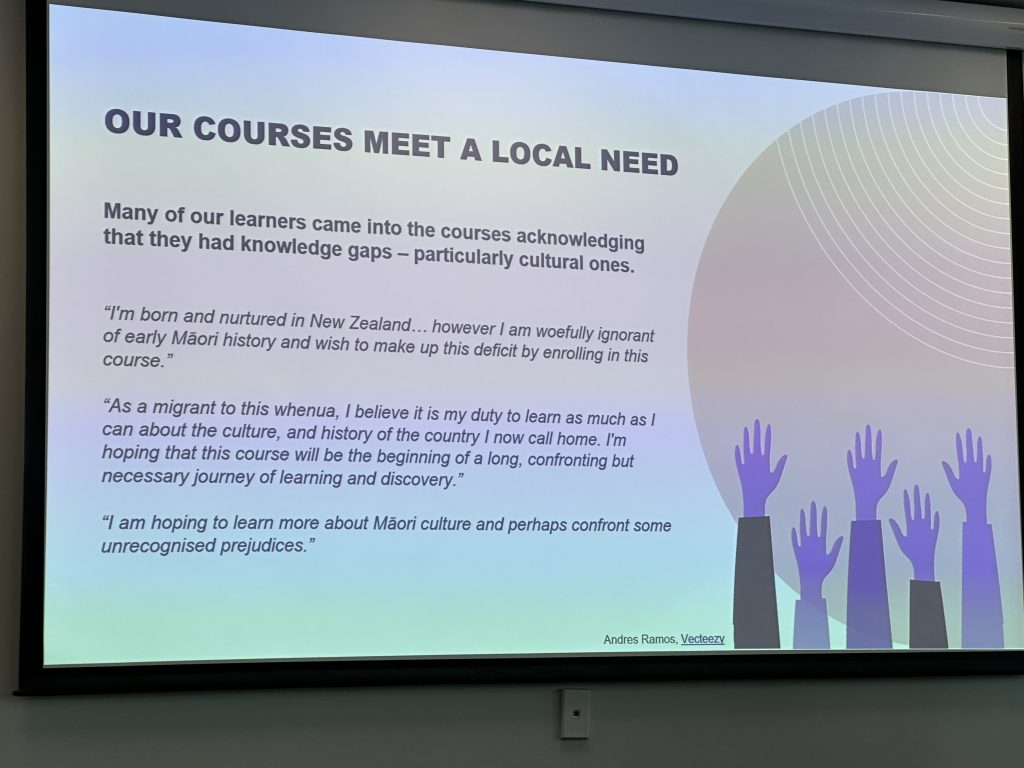
They chose to work with Future Learn because it was one of the few course providers to feature social learning. They created 7 courses, all free and open, and EducationNZ did the pilot and Te Papa got marketing help. Some of the courses were: NZ History and Culture, Biodiversity, and History of Protest. They said these courses meet a local need and have value, and that museums bring something unique in part because they have collections of objects that can be linked to the content. They noted that active facilitation and discussion were important to the learning, and they were pleased to see the courses receive thousands of comments and that the learning was extended. The courses helped to support NZ teachers, especially relating to the updated NZ history curriculum, and drew people to Te Papa’s other offerings. The Te Papa website was now a go-to source for some of them for accessible, trustworthy information. They said next steps are to announce a new partner in the next couple months and ask the audience what courses they want.
Dr. Lynda Kelly (Lynda Kelly Networks) – Visitors, Big Issues. Where does GLAM fit?
In her work on audience research and evaluation for museums, Kelly has come across the key question: What role do museums have in discussing contemporary topics or controversial topics? She reviewed her research about what people are worried about. For teachers, it’s climate, emotional issues, and social media challenges. For teacher librarians, it’s gender issues, war, and mental health. For teenage students, it’s big issues like climate and mental health, but also immediate issues in their lives like exams. She recommended checking out Australian-based research company McCrindle and their research on young people.
She prompted the question: How might GLAM do something about these issues? She said people are looking for more immersive experiences, not static ones, due to high use of technology during lockdown, but how do we change the GLAM perception of “look don’t touch”. Also, parents want a screen-free experience for children and audiences in general are tired of screens, so essentially they want immersive experiences without necessarily having screens.

For sources of information, teenagers and young people use TikTok for information, skills development, and event planning. There was a big loss of museum educators during the pandemic. She said there is a need to get people excited to visit in the first place (onsite and online) before beginning to customize their experience. Also, people want a WE experience, not a ME experience.
Te Wainui Witika-Park (Catalyst IT) – Small Changes, Big Impact
Witika-Park is a computer science grad from Victoria University who now works at Catalyst IT, which developed Koha, the first free and open source library management system. She shared some of the challenges in having an accessible experience online for people like her with low-vision or who need to use a screen reader. She provided live examples of good/bad design with a screen reader reading through webpages and showed how small changes in websites and design could make a big difference for those who can’t easily refer to colors and texts on screen. One example she called out for conference presenters was to please describe what’s on the screen, rather than saying “as you can see on the slide” because not everyone can see it, whether due to a disability or the text being too small, etc. She emphasized that you don’t have to jeopardize the look and feel of a website for accessibility. Things to do include having proper headings (H1, H2…) to make it easier for audiences to move through websites with their screen readers, and switching the order of page titles (the ones that appear at the top of the web browser tab) so the description is first, rather than the main title. E.g. if you have multiple pages open that all start with Google News or Google Images, it’s hard to see what’s in them, and it takes longer to have to tab through them with the screen reader because it has to read the main title first each time. She also said that -forms need a legend to give context and tables need captions. If it seems redundant on the page, you can make it Screen Reader Only so it’s visually hidden.
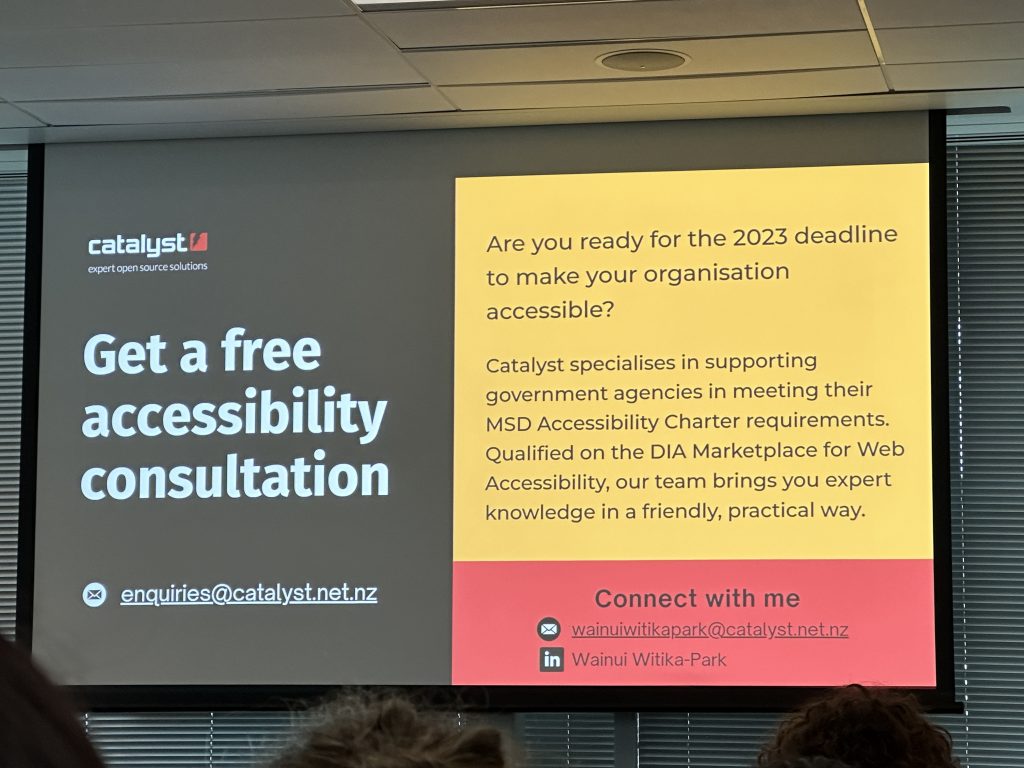
Ed Rodley (The Experience Alchemists) – Some Parting Thoughts
Rodley began by saying he was here because of Twitter and WordPress and his building of a diverse, global network through three years of being on Twitter and blogging, but as time has gone on, online gardens have become paywalled or stink. He gave a quote from Arundhati Rory on how the pandemic is a portal.
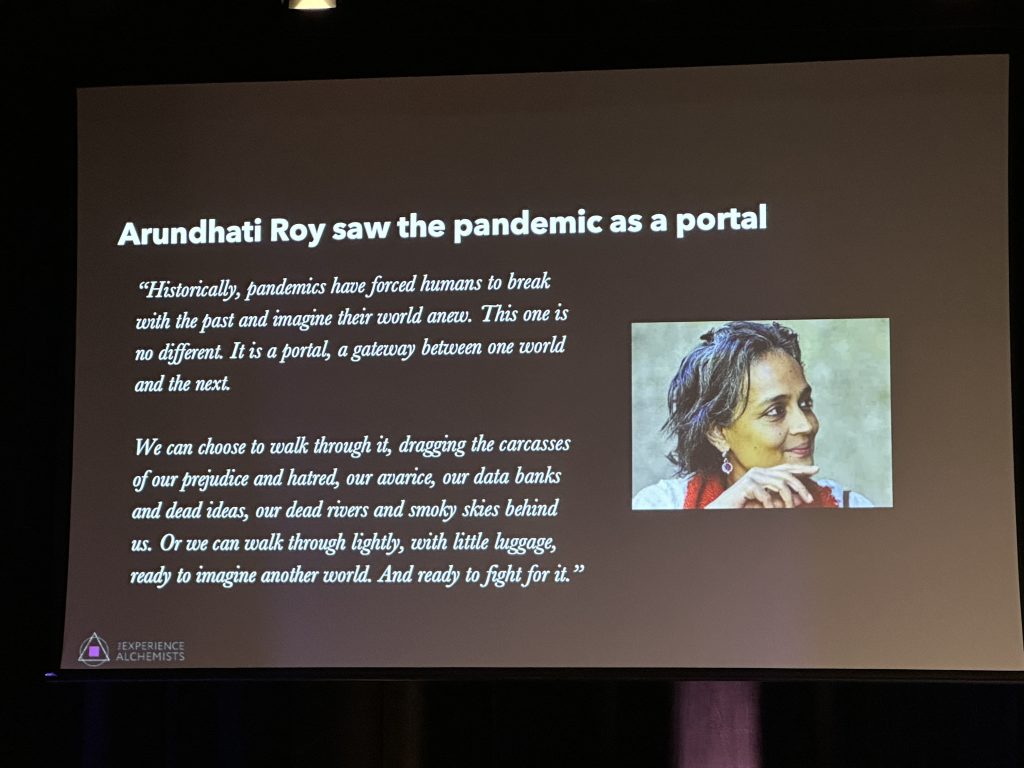
He said everything is a designable source, meaning that doing the same old, same old is therefore a design choice. He echoed what other presenters had, that cultural organizations are great at additive change, but not subtractive change. He said he wasn’t advising prudence and didn’t believe we could wait it out. He then brought in some of the theory from world-building expert Mark Wolf (whose work I really appreciate and have used in a couple journal articles with my science fiction scholarship) about immersing audiences and the benefits of immersion.